c h r o n o l o g i c a l
g u i d e
> Year 1 Year 2 <
> Year 3 Year 4 <
> Year 5 Year 6 <
> Year 7 Year 8 <
> Year 9 Year 12 <
fetching & dismantling
sandblasting & evil rust
right "b" pillar
fixing right inner sill
basic body repair, por-15
frame removed, footwell repair
hole fixed, car flipped, etc.
sill stiffeners, rear bulkhead, etc.
various small parts
left sill, added stiffener, etc.
- lousy weather
trunk floor (reprise)
right floor, left sill, etc.
left floor, wheel well, etc.
right upper wishbone
floor done, car righted
rack, front frame, evil rust
left door cleaned & fitted
right door, right suspension
bonnet, part 1
bonnet, part 2
bonnet, part 3
bonnet, part 4
bonnet, part 5, etc.
bonnet, part 6
bonnet, outer sill, etc.
lots of stuff
left side, bonnet internals
frame, bonnet attached
engine stand, oil pan removal
pistons removed, sanding
sanding, final filling
color, frames, primer
brushed primer test
2nd coat primer
holiday greetings!
finish prep, detail on dent fix
spraying primer
winter chores
1. undercoat, plating prep
2. plating, spraying color
bonnet, plate prep, cylinder head
cylinder head paint, bushes
plating saga
front frame, suspension, part 1
front suspension, part 2
front suspension, part 3
priming and painting
bonnet, part 7
painting color!
boot lid, steering wheel
gas tank
winter chores
1. firewall sundry
2. front suspension
3. steering setup
4. master cylinders/pedals
5. the rest
data plate screed
winter to spring
1. irs rebuild
2. trunk floor, harness
3. data plate (again)
data plate, door, headlights
dash vinyl, crosshatch aluminum
windshield, right door
interior, "widget"
chrome parts!
door handle details
rolling chassis
molasses rust removal
electrical, part 1
bores, thrust washers
new engine!
head differences
block differences
compression ratio
engine in place!
alternator
catchup & photos
it runs!
setback and brakes
darned close & engine diffs
driven
top and seats
driving and little stuff
|
|
|
Gas Tank Cleanup and Sealing
The gas tank had waited in the chicken coop for two years. That was long enough to take on a couple of boarders — mice who built a nice soft nest behind an inside
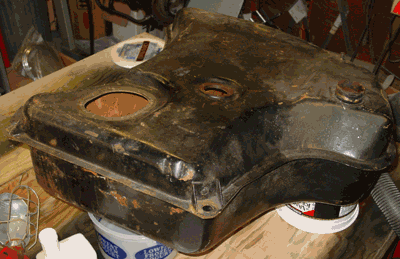 baffle. In spite of the fact that the gas tank was bone dry from the first day we got the car, I know that mice hadn't invaded until we took possession. The
nest I pulled out piece by piece and sucked out with my shop vacuum was made of our brand of paper towel and a cotton swab or two that had been lying around.
I had to use some wire to fish out the little bits. Time to set more traps, I guess.
baffle. In spite of the fact that the gas tank was bone dry from the first day we got the car, I know that mice hadn't invaded until we took possession. The
nest I pulled out piece by piece and sucked out with my shop vacuum was made of our brand of paper towel and a cotton swab or two that had been lying around.
I had to use some wire to fish out the little bits. Time to set more traps, I guess.
I glanced inside the tank when we put it into storage, and I recall thinking that it was pretty rusty, though I was also happy that the tank was completely
empty and had been for some time. Perhaps it is a matter of perspective now, but looking at it after two years of repairing other (worse?) rust made it seem
a little better. The rust inside was scary nonetheless. There was a welded repair that had been covered with blue silicone sealer. I recall the previous owner
pointing to some blue stuff and saying "Kreem?" but I have to admit that "Kreem" didn't make much sense to me then. Now I know it is a type of gas tank sealer.
Our closer look inside the tank showed us that the tank had never before been treated with a gas tank sealer. That fact simplified our work, since we wouldn't
have to remove a previous sealer to apply our own.
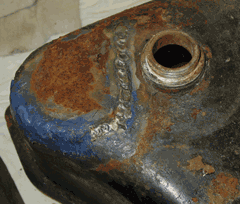
The underside of the tank, on the corner nearest the threaded hole for the fuel sump, had been repaired by cutting out a rusted area and patching it. The rest of the tank wall
was unmolested and solid. The rust repair was probably done at the same time as the "repair" of the fuel sump hole on the trunk floor that we redid.
This area of the E-type is commonly rusted, I've heard. It can collect water, since it is in close proximity to a hole fairly near the pavement and since Jaguar apparently
used jute pads to soundproof. The jute pads were situated between the gas tank and the floor of the trunk. Unfortunately, they soaked up moisture and eventually promoted
rust.
Bottom line: We didn't need to do rust damage repair, though sealing and removal of lesser rust deposits were still needed.
I decided to use POR-15's "US Standard Fuel Tank Sealer" kit. I'd read positive reviews, and I've been overall happy with other POR-15 products I've used. I know that
the rust protection coating is mighty tough stuff, and I figured the sealer would be tough, too. Also, I was attracted by the simplicity of buying a kit that included
everything I'd need. Cost was in line with what I expected: 50-75 USD. My kit arrived with two quarts of "Marine Clean" detergent, a quart of "Metal Ready" rust converter
and metal etcher, a quart of sealer, and a large-ish container of fuel treatment, that I won't use until I actually put gas into the tank. A single letter-sized sheet
contains all of the instructions. In short, you clean the tank thoroughly, convert any remaining rust and etch the steel, and then coat with the sealer. (See the
sidebar for all the details of our sealing job.)
Since I wanted to make the most out of the detergent that came from POR-15, I decided to do a pre-cleaning of the inside of the tank. There was no sense in pouring in the
special detergent to do what regular old "industrial strength" degreaser-detergent would do. To that end, I used a 1:1 dilution of Kirkland brand (yes, it came from Costco)
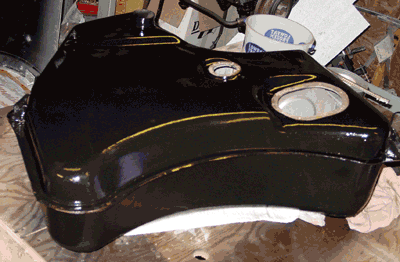 "industrial/commercial" degreaser-detergent. This stuff is colored a flourescent-like green. I've used it to degrease parts and I've even used it — with spotty results — to
clean items that were to be zinc plated. It has worked very well to remove grits and greasy deposits. I used the regular degreaser in the same manner that the POR-15 folks recommended using their "Marine Clean"
detergent. The first cleaning really took out a lot of junk, both loose chunks of grit and flaked rust and dissolved goo. The detergent mix came out looking like eight-hour
old espresso. After a clean water rinse, I redid it. The second batch of detergent came out signficantly more clean, but still definitely brown. The third batch came out
virtually the same color as it went in (see the left half of the comparison picture in the sidebar), so I figured that the detergent had done as much as it could.
"industrial/commercial" degreaser-detergent. This stuff is colored a flourescent-like green. I've used it to degrease parts and I've even used it — with spotty results — to
clean items that were to be zinc plated. It has worked very well to remove grits and greasy deposits. I used the regular degreaser in the same manner that the POR-15 folks recommended using their "Marine Clean"
detergent. The first cleaning really took out a lot of junk, both loose chunks of grit and flaked rust and dissolved goo. The detergent mix came out looking like eight-hour
old espresso. After a clean water rinse, I redid it. The second batch of detergent came out signficantly more clean, but still definitely brown. The third batch came out
virtually the same color as it went in (see the left half of the comparison picture in the sidebar), so I figured that the detergent had done as much as it could.
At that point, I began using the "Marine Clean." Now, "Marine Clean" is a clear liquid, and the POR-15 people claim that it dissolves varnishes and residues that result
from oxidizing fuels. Apparently this works in gas lines as well as gas tanks. I actually wasn't expecting the "Marine Clean" to get as much out of the tank as it in fact
did, since I'd already cleaned the tank with some also pretty tough detergent. That "Marine Clean" really works — the first 1:1 dilution came out significantly
brown, indicating it was at least dissolving what my other detergent couldn't. The second dilution also came out somewhat brown. One thing that was a bit unsual was that the
instructions suggested that there was a third application of the "Marine Clean," but my kit contained two quarts of the stuff. I figured that the POR-15 people
decided that three was overkill and two would suffice.
The test of the relative strength of a "industrial" degreaser-detergent and the POR-15 "Marine Clean" detergent was really the only surprise in the process of sealing
the gas tank. The rest of the process went without much to note.
After the inside was sealed, I painted the outside of the tank. I did decide to mask the areas where the fuel pump and the fuel level sensor attach as well as the threads
for the fuel sump. These now are clean metal. I am thinking about installing a different (more dependable?) fuel pump, though I'm not sure what type, submersible or not.
That is a question I do not need to answer right now, however.
The gas tank looks nice. I'll have to keep more rodent boarders from moving in!
|
Gas Tank Treatment, Step-By-Step
POR-15 Fuel Tank Sealer Kit

Pretty scary, I thought, when I first took a look at the inside of the gas tank. This area is the welded repair that must have been associated with the rusted out trunk.
I think that the rusted out trunk floor became a problem when gas began to leak. The area immediately adjacent to the welded repair on the tank exterior
had some pitting as well.
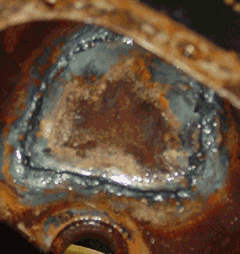
The instructions for the tank kit said to clean the tank with the "Marine Clean" detergent, diluted 1:1. I decided to use some regular old "industrial degreaser-detergent"
(purchased from Costco) to do the initial cleaning. This entailed sloshing around a 1:1 mixture of water and degreaser. I did this three times, and I let the detergent soak for about an hour in the tank. The first time the mixture
came out a coffee-colored liquid. After a clean water rinse and another Costco-brand slosh, the detergent had done as much as it could. It came out almost completely the
color it went in. The picture above shows the results on the interior — there were some results but the best was yet to come.
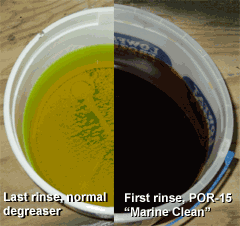
The picture shows the last Costco-brand detergent and the first "Marine Clean" detergent mix. It's pretty obvious that the Costco detergent had done its best. And the "Marine Clean"
— which went in completely colorless — came out quite brown. The "Marine Clean" detergent is claimed to remove fuel residues and varnishes that appear
in fuel tanks and fuel lines. I was skeptical, but I was pleasantly surprised by the result, especially after I had cleaned up as best as I could with other detergent.
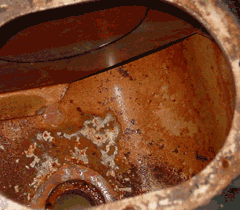
This shows the tank floor after two applications of the "Marine Clean" detergent. Although the instructions said that the final detergent soaking would pour out almost clean, that
was not my experience. That second soak came out brownish, too. I'm assuming this second application was adequate, since a third quart of "Marine Clean" did not come
in my kit, although the instructions mention a third application of the diluted detergent. What is shown here really amounts to a thin coating of rust. I could easily rub it off with my fingertips.
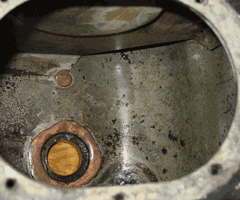
After the inside is free of greases, oils, and varnish, the rust is converted with a product called "Metal Ready." Basically, this converts iron oxide rust and etches the metal
surface. This left (or, perhaps more accurately, replaced) the rust film with a grey film that came off just as easily as the rust. This picture shows the treated surface after
it had been rinsed with clean water. The surface came quite clean, since you can see the brazed welds quite easily and the steel looks like steel.
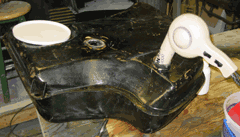
An old hair dryer served as the forced air source. It was perfect, since I just shoved it in a hole and turned it on. For the most part, I kept the dryer running without
using the heater. Hot air went in about three hours all told, and it definitely heated the tank. Overall, I ran the hair dryer about ten hours. Completely drying
the inside of the tank is very important, and the kit instructions especially stress this. The tank sealer will not adhere to a wet or moist tank wall.
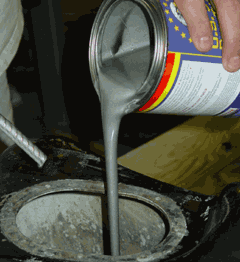
The POR-15 kit comes with a quart of fuel tank sealer, which looks to me to be the same stuff as POR-15 metal coating. Stinks the same, at least, and it looks pretty much
the same, too. We duct taped the openings on the gas tank, poured the sealer into the very dry tank, and rotated it to make sure that the coating covered the
entire interior surface. After that, we poured the excess out — about a pint remained. The kit instructions said to leave the can open, so that it wouldn't
explode (!), and that does make me think that the sealer is somehow different from POR-15 metal coatings, since those are resealable, at least for short term.
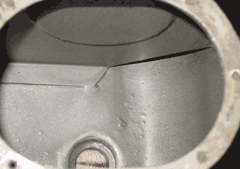
The inside of the tank now looks like this. The POR-15 instructions say that you can repair larger holes with a fabric-like product and POR-15 sealer applied to the
outside of the tank over the holes. Thank goodness we won't need to do that kind of thing!
|
|
|
|

